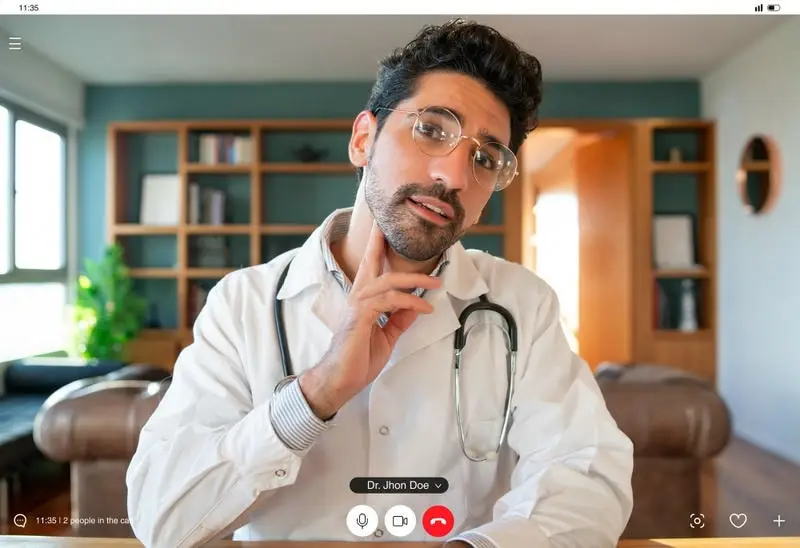- Published on: Nov 24, 2025
- 4 minute read
- By: Secondmedic Expert
AI-Powered Patient Monitoring India: The Future Of Connected Health And Predictive Care
AI-powered patient monitoring is transforming how India delivers continuous medical care, manages chronic illnesses, and ensures timely interventions. With rising demand for remote monitoring, digital health tools, and intelligent care pathways, AI-driven monitoring systems have become essential for the future of healthcare delivery in India. These systems leverage artificial intelligence, wearable devices, sensors, and digital health platforms to track vitals, detect abnormalities, and generate clinical insights in real time.
India’s growing digital healthcare ecosystem-supported by ABDM, telemedicine growth, and increasing wearable adoption-has created the perfect environment for AI-enabled monitoring. SecondMedic integrates advanced AI monitoring systems to empower patients and clinicians with accurate, continuous, and predictive health data.
Why India Needs AI-Based Patient Monitoring
India faces a high burden of chronic illnesses such as diabetes, hypertension, COPD, heart disease, and kidney disorders. According to WHO and ICMR data, chronic diseases account for over 60% of deaths in the country. Traditional monitoring methods rely heavily on manual measurements and delayed doctor visits, leading to late detection and preventable emergencies.
AI-powered monitoring addresses these gaps through:
-
Real-time data tracking
-
Automated alerts before deterioration
-
Predictive modeling for disease trends
-
Reduced hospital visits
-
Better chronic disease management
-
Improved home-based care
SecondMedic uses AI to ensure patients receive consistent monitoring without depending solely on clinic visits.
How AI-Powered Monitoring Works
AI systems analyze incoming data from multiple devices, sensors, and digital platforms using real-time algorithms.
Common data inputs include:
-
Heart rate and ECG patterns
-
Blood oxygen saturation (SpO2)
-
Blood pressure trends
-
Glucose fluctuations
-
Respiratory patterns
-
Sleep cycles
-
Physical activity and movement data
-
Body temperature
-
Stress and HRV markers
AI compares these values with historical data, medically validated thresholds, and predictive models to detect abnormalities.
Applications in Chronic Disease Management
1. Cardiac Monitoring
AI interprets ECG signals to detect arrhythmias, ischemia, or stress-induced variations earlier than manual interpretation.
2. Diabetes Tracking
Continuous glucose monitors (CGMs) paired with AI predict patterns, spikes, or risks of hypoglycemia.
3. Respiratory Disorders
AI monitors breathing patterns and oxygen levels to detect early signs of COPD or asthma flare-ups.
4. Hypertension Management
Blood pressure monitors work with AI to predict future hypertension episodes.
5. Kidney and Liver Risk Tracking
AI analyzes lab reports and vitals to detect progressive disease pathways.
These applications support both preventive and long-term health management.
Remote Monitoring for Home-Based Care
India is experiencing a significant shift toward home-based healthcare, especially for elderly individuals, post-operative patients, and those with limited mobility.
AI remote monitoring offers:
-
24/7 supervision without hospital admissions
-
Reduced risk of emergencies
-
Lower medical expenses
-
Peace of mind for families
-
Real-time connection to doctors
SecondMedic’s integrated ecosystem ensures doctors can intervene promptly when alerts are triggered.
Predictive Healthcare with AI
Predictive alerts are one of the most significant advantages of AI monitoring. Instead of identifying problems after they occur, AI predicts deterioration before symptoms appear.
Examples include:
-
Predicting a heart rate anomaly hours before an arrhythmia episode
-
Detecting respiratory distress from subtle breathing pattern changes
-
Identifying early glucose instability trends
-
Predicting sleep apnea risks
-
Forecasting hypertension spikes
These capabilities help avoid hospitalizations and critical events.
Benefits for Patients and Healthcare Providers
Benefits for Patients
-
Early detection of health issues
-
Reduced hospital visits
-
Personalized care recommendations
-
Improved confidence and self-management
-
More control over long-term health
Benefits for Doctors
-
Access to continuous health data
-
Better understanding of patient progress
-
Reduced burden of manual follow-ups
-
Improved decision-making
-
Efficient telemedicine consultations
Role of Wearables and Smart Devices
India’s wearable adoption has rapidly increased, with millions using smartwatches and health trackers. These devices enable:
-
Continuous heart monitoring
-
Sleep tracking
-
Stress analysis
-
SpO2 measurement
-
Activity tracking
When linked to AI, they generate clinically meaningful insights.
Challenges and Future Directions
Challenges include device accuracy differences, data fragmentation, and digital literacy gaps. However, India’s growing digital health ecosystem is steadily resolving these issues through better standards, improved connectivity, and user-friendly platforms.
Future advancements will include:
-
AI-driven virtual ICUs
-
Automated triage systems
-
Integrated remote diagnostic hubs
-
Predictive emergency alerts
-
Fully connected doctor dashboards
SecondMedic is building intelligent, AI-driven monitoring solutions to support these advancements.
Conclusion
AI-powered patient monitoring India is revolutionizing healthcare by offering real-time tracking, predictive alerts, and continuous health insights. With rising chronic disease rates, busy lifestyles, and increasing adoption of digital health technologies, AI monitoring ensures timely interventions, improved outcomes, and enhanced patient safety.
To explore AI-based monitoring and digital healthcare solutions, visit www.secondmedic.com
References
-
WHO - Remote monitoring and chronic disease data
-
ICMR - Chronic disease burden in India
-
ABDM - Digital health ecosystem guidelines
-
Statista - Wearable adoption in India
-
IMARC - India remote monitoring market
-
SecondMedic clinical insights
Read FAQs
A. It is an intelligent system that tracks vitals, detects abnormalities, and sends alerts using AI-driven algorithms.
A. Heart rate, ECG, oxygen levels, blood pressure, glucose, sleep patterns, respiratory rate, and more.
A. Patients with chronic diseases, elderly individuals, post-surgery patients, and remote populations.
A. Yes. SecondMedic uses connected devices and AI insights to support remote and continuous monitoring.
A. Yes. AI improves accuracy through real-time data comparison, predictive modeling, and anomaly detection.









